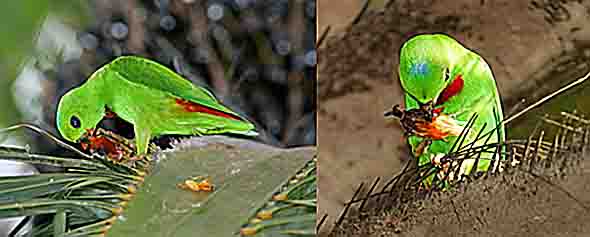Palms are commonly planted in gardens and parks all over Singapore. They are impressive looking, with their tall, straight trunk, some slender other massive, bearing a mass of feathery fronds at the top. However, because they do not provide much shade, they are seldom planted along the wayside. These plants contribute much to the avian biodiversity of our garden city.
Nesting
Some birds build their nests between the frond bases LINK or on the undersurface of the fronds LINK. Others excavate cavities in the rotting stem LINK.

Nectar
Birds (as well as insects and other animals) are attracted to the nectar secreted by the flowers. For example, sunbirds collect nectar from flowers of Coconut (Cocos nucifera) LINK. In the process they help to pollinate the flowers. Parakeets have been documented eating palm flowers for the nectar they contain LINK. Whether this results in pollination needs to be established

Fruits
The one-seeded palm fruits are the major attraction for birds. About 20 species of birds that feed on the fruits have been documented in this website. More have yet to be documented. Depending on the size of the fruits and the gape of the birds, palm fruits are either swallowed whole or the outer flesh is torn off piece by piece.
In swallowing the fruits, seeds are effectively dispersed some distance away. This happens in one of two ways. The seeds can be regurgitated after the flesh is scraped off in the crop or they can be passed off as droppings. In the case of the latter the seeds are dispersed a longer distance away as passage through the alimentary canal takes time.
Seed regurgitating is seen among koels, starlings and hornbills.
Small birds with narrow gape like flowerpeckers, mynas and bulbuls tear off the flesh, dropping the partially eaten fruits around the base of the palm. The seeds are not properly dispersed here.

Hanging-parrots, laughingthrushes and parakeets similarly eat by tearing pieces of the outer flesh. These birds again do not contribute to seed dispersal.
For a complete list of palms and the birds that interact with them, check out this LINK.
YC Wee
Singapore
26th June 2017








